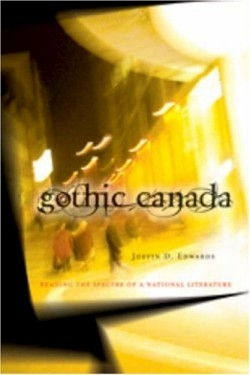Gothic Canada
Reading the Spectre of a National Literature
Four crumbling tombstones were uncovered in a Canadian field, where they marked the resting place of a secret that would forever disrupt the local community. The graves belonged to “former African slaves and black veterans of the War of 1812” and dated from the time of the town’s founding. Suddenly, the accepted history of European settlement was called into question. Anxieties about unearthing a past of violence and miscegenation so disturbed some of the townspeople that they opposed further investigation of the area in which the tombstones had been discovered. This book features such repressed histories, confused identities, graves, and ghostly reminders—classic elements of gothic fiction.
The author is associate professor of English at the University of Copenhagen; his previous works include Exotic Journeys: Exploring the Erotics of U.S. Travel Literature and Gothic Passages: Racial Ambiguity and the American Gothic. Here, he uses the true story of Priceville to introduce and frame his study of a selection of Canadian literature. As a Canadian, he is familiar with the complexities of identity that his citizenship entails; as a literary scholar, he is concerned with individual and social identities and how they are represented and explored in texts.
The scope of this volume is broad, encompassing a multitude of topics. Canadian literature produced in the past two centuries provides abundant material for investigation. Edwards aims to explore the literature, wandering through its forests, diving into its abysses, weathering its howling storms, exhuming its corpses, and entering its decaying edifices. The journey has no specific destination; it is shaped only by his questions: “How are the categories of nationhood and the rhetoric of national difference tied to the language of gothicism? What can these discursive ties tell us about a range of other personal and social boundaries … in literary production? What, then, can the construction and destabilization of these boundaries tell us about the development of a gothic tradition in Canada?”
Canadians, Edwards posits, suffer from an inability to reconcile conflicting identities in order to arrive at some stable and unified sense of self. They are perpetually torn between old ties to Europe and proximity to the United States, and can only define their nationality in opposition to other nations. Similarly, they are both colonized and colonizers, oppressed and oppressors. In short, “Canada is an in-between space,” and this fact is manifest in the psyches of the nation and its people.
Each of the eight chapters of Gothic Canada examines Canadian identity from a unique perspective and incorporates different texts to show how these perspectives are represented in the national literature. “Niagara’s Abyss, or Locating the Gothic Sublime,” takes as its focus Canadians’ problematic relationship to the physical landscape. Susanna Moodie’s Life in the Clearing Versus the Bush and Jane Urquhart’s The Whirlpool both depict the famous Falls at Niagara as overwhelming spectators with the tremendous awe and terror that characterize the sublime. In Moodie’s novel, the rushing, roaring waters are feared for their potential to “annihilate” one’s identity, but also admired for their “wild ecstasy of freedom and power.” The Whirlpool concentrates on how the turbulent, tumultuous waters twisting below the Falls inspire perilous, even fatal, obsessions. Edwards reads in these gothic representations feelings of alienation and suggests that the essence of Canada cannot be approached; Canadians who seek to discover the land and nation they inhabit are repelled, left to endure an endless tension between desire and denial.
This pattern of analysis is consistent throughout Edwards’s study, despite thrilling topical shifts. In “Dark Cities and Blank Fictions,” urban spaces, long repressed by images of Canada as a vast wilderness, are uncovered. The city landscapes presented in the plays of Brad Fraser and the short stories of Andrew Pyper are bleak, confusing, and haunted by citizens without clear identities. Figures in these fictions are unidentifiable, unrecognizable, and effaced. In the place of a stable sense of self, Edwards contends, is “a void on which excess, indulgence, decadence, consumption and violence are inscribed.”
Gothic Canada is a serious and sophisticated guide to examples of the gothic in Canadian literature. Edwards embarks on a fascinating and timely scholarly investigation. It reflects a growing interest in Canadian literature, and is sure to contribute to the trend. The book enters into contemporary conversations about identity, ethnicity, space, gender, sexuality, and postcolonialism. It expands on previous theories of gothic and Canadian literatures, and develops some new ones.
Edwards looks for ghosts and finds them. More importantly, he explains why they haunt the pages of Canadian literature.
Reviewed by
Melissa Moore
Disclosure: This article is not an endorsement, but a review. The publisher of this book provided free copies of the book to have their book reviewed by a professional reviewer. No fee was paid by the publisher for this review. Foreword Reviews only recommends books that we love. Foreword Magazine, Inc. is disclosing this in accordance with the Federal Trade Commission’s 16 CFR, Part 255.

